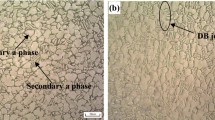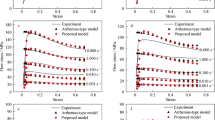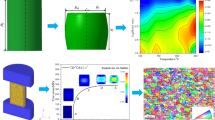Abstract
Isothermal compression tests of TC4-DT titanium alloy at the deformation temperature ranging from 1181 to 1341 K covering α + β phase field and β-phase field, the strain rate ranging from 0.01 to 10.0 s−1 and the height reduction of 70% were conducted on a Gleeble-3500 thermo-mechanical simulator. The experimental true stress-true strain data were employed to develop the strain-compensated Arrhenius-type flow stress model and artificial neural network (ANN) model; the predictability of two models was quantified in terms of correlation coefficient (R) and average absolute relative error (AARE). The R and AARE for the Arrhenius-type flow stress model were 0.9952 and 5.78%, which were poorer linear relation and more deviation than 0.9997 and 1.04% for the feed-forward back-propagation ANN model, respectively. The results indicated that the trained ANN model was more efficient and accurate in predicting the flow behavior for TC4-DT titanium alloy at elevated temperature deformation than the strain-compensated Arrhenius-type constitutive equations. The constitutive relationship compensating strain could track the experimental data across the whole hot working domain other than that at high strain rates (≥1 s−1). The microstructure analysis illustrated that the deformation mechanisms existed at low strain rates (≤0.1 s−1), where dynamic recrystallization occurred, were far different from that at high strain rates (≥1 s−1) that presented bands of flow localization and cracking along grain boundary.











Similar content being viewed by others
References
R.R. Boyer, An Overview on the Use of Titanium in the Aerospace Industry, Mater. Sci. Eng. A, 1996, 213(1–2), p 103–114
Y. Kim, E.-P. Kim, Y.-B. Song, S.H. Lee, and Y.-S. Kwon, Microstructure and Mechanical Properties of Hot Isostatically Pressed Ti–6Al–4V Alloy, J. Alloys Compd., 2014, 603(1), p 207–212
N. Poondla, T.S. Srivatsan, A. Patnaik, and M. Petraroli, A Study of the Microstructure and Hardness of Two Titanium Alloys: Commercially Pure and Ti–6Al–4V, J. Alloys Compd., 2009, 486(1–2), p 162–167
P. Guo, Y. Zhao, W. Zeng, and Q. Hong, The Effect of Microstructure on the Mechanical Properties of TC4-DT Titanium Alloys, Mater. Sci. Eng. A, 2013, 563, p 106–111
X.N. Peng, H.Z. Guo, Z.F. Shi, C. Qin, and Z.L. Zhao, Constitutive Equations for High Temperature Flow Stress of TC4-DT Alloy Incorporating Strain, Strain Rate and Temperature, Mater. Des., 2013, 50, p 198–206
X.N. Peng, H.Z. Guo, T. Wang, and Z.K. Yao, Effects of β Treatments on Microstructures and Mechanical Properties of TC4-DT Titanium Alloy, Mater. Sci. Eng. A, 2012, 533, p 55–63
Y.V.R.K. Prasad, T. Seshacharyulu, S.C. Medeiros, and W.G. Frazier, Influence of Oxygen Content on the Forging Response Of Equiaxed (α + β) Preform of Ti–6Al–4V: Commercial vs. ELI, Grade, J. Mater. Process. Technol., 2001, 108(3), p 320–327
P. Haupt and Th Kersten, On the Modelling of Anisotropic Material Behaviour in Viscoplasticity, Int. J. Plast, 2003, 19(11), p 1885–1915
M. Rajamuthamilselvan and S. Ramanathan, Hot Deformation Behaviour of 7075 Alloy, J. Alloys Compd., 2011, 509(3), p 948–952
J.L. Liu, W.D. Zeng, Y.J. Lai, and Z.Q. Jia, Constitutive Model of Ti17 Titanium Alloy with Lamellar-Type Initial Microstructure During Hot Deformation Based on Orthogonal Analysis, Mater. Sci. Eng. A, 2014, 597, p 387–394
G.R. Ebrahimi, A.R. Maldar, R. Ebrahimi, and A. Davoodia, Effect of Thermomechanical Parameters on Dynamically Recrystallized Grain Size of AZ91 Magnesium Alloy, J. Alloys Compd., 2011, 509(6), p 2703–2708
B.K. Raghunath, K. Raghukandan, R. Karthikeyan, K. Palanikumar, U.T.S. Pillai, and R. Ashok Gandhie, Flow Stress Modeling of AZ91 Magnesium Alloys at Elevated Temperature, J. Alloys Compd., 2011, 509(15), p 4992–4998
J. Xiao, D.S. Li, X.Q. Li, and T.S. Deng, Constitutive Modeling and Microstructure Change of Ti–6Al–4V During the Hot Tensile Deformation, J. Alloys Compd., 2012, 541, p 346–352
Y.Q. Ning, Z.K. Yao, H.Z. Guo, and M.W. Fu, Hot Deformation Behavior and Hot Working Characteristic of Nickel-Base Electron Beam Weldments, J. Alloys Compd., 2014, 584, p 494–502
F.A. Slooff, J. Zhou, J. Duszczyk, and L. Katgerman, Constitutive Analysis of Wrought Magnesium Alloy Mg–Al4–Zn1, Scripta Mater., 2007, 57(8), p 759–762
Y.C. Lin, M.S. Chen, and J. Zhong, Prediction of 42CrMo Steel Flow Stress at High Temperature and Strain Rate, Mech. Res. Commun., 2008, 35, p 142–150
Y. Sun, W.D. Zeng, Y.Q. Zhao, Y.L. Qi, Y.F. Han, Y.T. Shao, and X. Ma, Modeling of Constitutive Relationship of Ti600 Alloy Using BP Artificial Neural Network, Rare Metal Mater. Eng., 2011, 40(2), p 220–224 ((in Chinese))
Y. Sun, W.D. Zeng, Y.Q. Zhao, X.M. Zhang, X. Ma, and Y.F. Han, Constructing Processing Map Of Ti40 Alloy Using Artificial Neural Network, Trans. Nonferr. Metals Soc. China, 2011, 21(1), p 159–165
N. Haghdadi, A. Zarei-Hanzaki, A.R. Khalesian, and H.R. Abedi, Artificial Neural Network Modeling to Predict the Hot Deformation Behavior of an A356 Aluminum Alloy, Mater. Des., 2013, 49(1), p 386–391
Y.C. Zhu, W.D. Zeng, Y. Sun, F. Feng, and Y.G. Zhou, Artificial Neural Network Approach to Predict the Flow Stress in the Isothermal Compression of As-Cast TC21 Titanium Alloy, Comput. Mater. Sci., 2011, 50(5), p 1785–1790
Y.F. Han, W.D. Zeng, Y.Q. Zhao, X.M. Zhang, Y. Sun, and X. Ma, Modeling of Constitutive Relationship of Ti–25 V–15Cr–0.2Si Alloy During Hot Deformation Process by Fuzzy-Neural Network, Mater. Des., 2010, 31(9), p 4380–4385
D. Samantaray, S. Mandal, and A.K. Bhaduri, Optimization of Hot Working Parameters for Thermo-mechanical Processing of Modified 9Cr–1Mo (P91) Steel Employing Dynamic Materials Model, Mater. Sci. Eng. A, 2011, 528(15), p 5204–5211
T. Seshacharyulu, S.C. Medeiros, W.G. Frazier, and Y.V.R.K. Prasad, Hot Working of Commercial Ti–6Al–4 V with an Equiaxed α–β Microstructure: Materials Modeling Considerations, Mater. Sci. Eng. A, 2000, 284(1–2), p 184–194
D. Samantaray, S. Mandal, and A.K. Bhaduri, Constitutive Analysis to Predict High-Temperature Flow Stress in Modified 9Cr-1Mo(P91) Steel, Mater. Des., 2010, 31(2), p 981–984
Y.C. Lin, M.S. Chen, and J. Zhang, Modeling of Flow Stress of 42CrMo Steel Under Hot Compression, Mater. Sci. Eng. A, 2009, 499(1–2), p 88–92
G.L. Ji, F.G. Li, Q.H. Li, H.Q. Li, and Z. Li, A Comparative Study on Arrhenius-Type Constitutive Model and Artificial Neural Network Model to Predict High-Temperature Deformation Behaviour in Aermet100 Steel, Mater. Sci. Eng. A, 2011, 528(13–14), p 4774–4782
Z.W. Yuan, F.G. Li, H.J. Qiao, and G.L. Li, Constitutive Flow Behavior and Hot Workability of AerMet100 at Elevated Temperatures, J. Mater. Eng. Perform., 2014, 23(6), p 1981–1999
X.P. Liang, Y. Liu, H.Z. Li, C.X. Zhou, and G.F. Xu, Constitutive Relationship for High Temperature Deformation of Powder Metallurgy Ti–47Al–2Cr–2Nb–0.2W Alloy, Mater. Des., 2012, 37(1), p 40–47
Acknowledgments
The authors would like to acknowledge the support of the Major State Basic Research Development Program of China (973 Program) with No. 2007CB613807, the Doctoral Fund of Ministry of Education of China with No. 20116102110015, the New Century Excellent Talents in University with No. NCET-07-06966, and the Doctoral Fund of Ministry of Education of China with No. 20136102110034. Shaanxi province science and technoogy integrated innovation engineering project (2012KTZB01-03).
Author information
Authors and Affiliations
Corresponding author
Rights and permissions
About this article
Cite this article
Liu, J., Zeng, W., Zhu, Y. et al. Hot Deformation Behavior and Flow Stress Prediction of TC4-DT Alloy in Single-Phase Region and Dual-Phase Regions. J. of Materi Eng and Perform 24, 2140–2150 (2015). https://doi.org/10.1007/s11665-015-1456-7
Received:
Revised:
Published:
Issue Date:
DOI: https://doi.org/10.1007/s11665-015-1456-7




